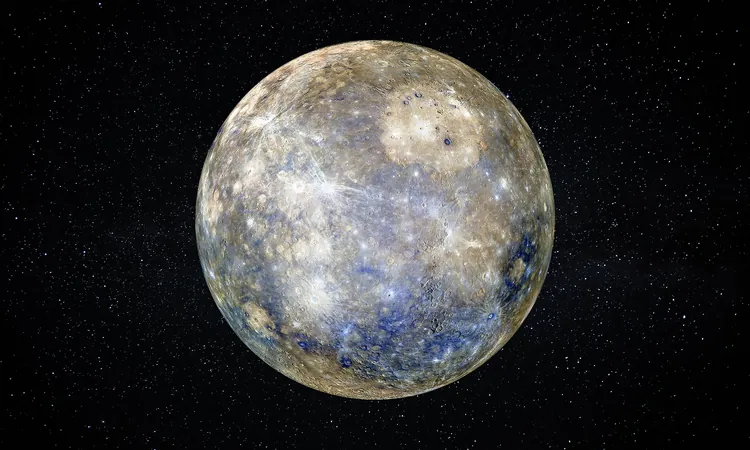
BepiColombo's Stunning Close Encounter with Mercury: High-Definition Images and Groundbreaking Discoveries Await!
2025-01-15
Author: Nur
In a breathtaking mission that is reshaping our understanding of Mercury, the BepiColombo spacecraft has executed a close flyby of the planet, capturing stunning high-definition images of the surface of our solar system's smallest planet.
Mercury, the closest planet to the Sun, is known for its extreme temperatures and unique geological features. It completes an orbit in just 88 Earth days—making its year the shortest in the solar system. Despite its sizzling proximity to the Sun, Mercury hosts a surprisingly large iron core that generates a robust magnetic field, giving it a unique character compared to other celestial bodies.
A Remarkable Flyby
On January 8, 2025, BepiColombo made its sixth close flyby, coming within a mere 295 miles of Mercury’s surface on the dark side of the planet. The spacecraft captured new images revealing the chilling beauty of Mercury’s northern plains, where some areas are perpetually shadowed and potentially harbor frozen water.
Frank Budnik, the BepiColombo Flight Dynamics Manager, expressed excitement regarding this operation, stating, "This is the first time we've conducted two flyby campaigns back-to-back, and based on our preliminary assessment, everything proceeded smoothly."
Chilling Discoveries
The flyby yielded tantalizing glimpses of Mercury's polar shadows, where craters like Prokofiev and Kandinsky are among the coldest locations in the solar system, raising intriguing questions about the possibility of frozen water nestled in these frigid recesses. As BepiColombo prepares for its eventual orbital insertion in late 2026, scientists eagerly await more detailed investigations into these mysteries.
Scientists were particularly thrilled about images of Borealis Planitia, a vast volcanic plain believed to have formed from lava flows approximately 3.7 billion years ago, obscuring ancient impact craters. Features like the Mendelssohn crater also sparked interest with their smooth surfaces, hinting at relict volcanic activity.
Insights into Mercury's History
One of the most captivating highlights of the mission is the Caloris basin, a spectacular impact feature that spans over 900 miles. Its immense size and the visible effects on Mercury's geology, including the intricate lines radiating from it, continue to evoke awe and curiosity.
In addition to capturing images of younger craters, like the Fonteyn crater—evidencing recent geological activity—BepiColombo is preparing to unlock the planet's history through further study. The darker surface of Mercury, more so than our Moon, allows bright deposits from volcanic eruptions and impacts to stand out.
What Lies Ahead
During the European Space Agency (ESA) Annual Press Briefing, ESA Director General Josef Aschbacher revealed the first images and underscored the significance of the flyby. As BepiColombo transitions into its orbital phase, mission teams plan to utilize advanced instruments to investigate both the surface composition and the long-debated existence of polar ice.
Analysts are particularly keen to determine how features like the volcanic plains and impact craters have evolved over billions of years, offering profound insights into Mercury’s formation and development.
The Final Countdown
As the countdown begins toward its long-awaited orbital operations, this flyby may mark the final close observations BepiColombo can make before its monitoring cameras detach from the primary modules in late 2026. The ESA's Mercury Planetary Orbiter and the JAXA Mercury Magnetospheric Orbiter will then shift focus to in-depth studies of the planet's geology and magnetic field.
With each revelation, the BepiColombo mission is poised to answer enduring questions about Mercury’s enigmatic nature. As Geraint Jones, BepiColombo's Project Scientist, stated, "In the coming weeks, we'll strive to unravel as many of Mercury’s mysteries from this flyby data as possible, bringing us closer to understanding the hidden complexities of our solar system’s inner workings."
As scientists look ahead, the anticipation builds—what secrets will the furthest reaches of Mercury reveal next? Stay tuned, as this mission promises to be an exciting chapter in the exploration of outer space!



 Brasil (PT)
Brasil (PT)
 Canada (EN)
Canada (EN)
 Chile (ES)
Chile (ES)
 Česko (CS)
Česko (CS)
 대한민국 (KO)
대한민국 (KO)
 España (ES)
España (ES)
 France (FR)
France (FR)
 Hong Kong (EN)
Hong Kong (EN)
 Italia (IT)
Italia (IT)
 日本 (JA)
日本 (JA)
 Magyarország (HU)
Magyarország (HU)
 Norge (NO)
Norge (NO)
 Polska (PL)
Polska (PL)
 Schweiz (DE)
Schweiz (DE)
 Singapore (EN)
Singapore (EN)
 Sverige (SV)
Sverige (SV)
 Suomi (FI)
Suomi (FI)
 Türkiye (TR)
Türkiye (TR)
 الإمارات العربية المتحدة (AR)
الإمارات العربية المتحدة (AR)